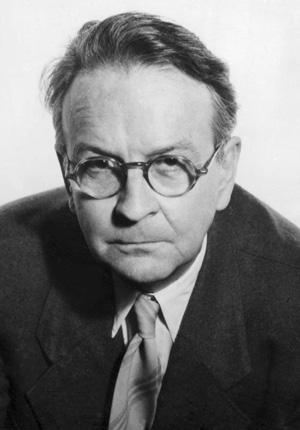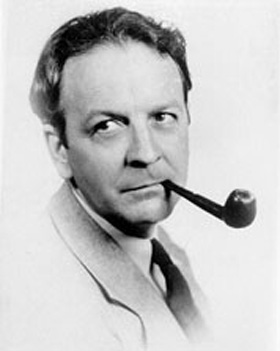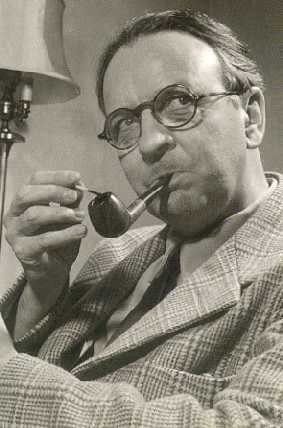<Back to Index>
- Physicist Wolfgang Gentner, 1906
- Novelist Raymond Thornton Chandler, 1888
- Duke of Milan Francesco I Sforza, 1401
PAGE SPONSOR



Raymond Thornton Chandler (July 23, 1888 – March 26, 1959) was an Anglo-American novelist and screenwriter who had an immense stylistic influence upon the modern private detective story, especially in the style of the writing and the attitudes now characteristic of the genre. His protagonist, Philip Marlowe, along with Dashiell Hammett's Sam Spade, is considered synonymous with "private detective", both being played on screen by Humphrey Bogart.
Chandler was born in Chicago, Illinois, in 1888, and moved to London, United Kingdom in 1900 with his Irish-born mother after they were abandoned by his father, an alcoholic civil engineer who worked for a North American railway company. His uncle, a successful lawyer, supported them. After attending a local school in Upper Norwood, Chandler was classically educated at Dulwich College, London (a public school whose alumni also include the authors P.G. Wodehouse and C.S. Forester). He did not attend university, instead spending time in Paris and Munich. In 1907, he was naturalised as a British subject in order to take the civil service examination, which he passed with the third highest score. He then took an Admiralty job, lasting just over a year. His first poem was published during that time.
Chandler disliked the servility of the civil service and resigned, to the consternation of his family, becoming a reporter for the Daily Express and the Bristol Western Gazette newspapers. He was an unsuccessful journalist, published reviews and continued writing romantic poetry. Accounting for that time he said, "Of course in those days as now there were... clever young men who made a decent living as freelances for the numerous literary weeklies..." but "...I was distinctly not a clever young man. Nor was I at all a happy young man."
In 1912, he borrowed money from his uncle (who expected it to be repaid with interest), and returned to North America, eventually settling in Los Angeles with his mother in 1913. He strung tennis rackets, picked fruit and endured a lonely time of scrimping and saving. Finally, he took a correspondence bookkeeping course, finished ahead of schedule, and found steady employment. In 1917, when the US entered World War I, he enlisted in the Canadian Expeditionary Force, saw combat in the trenches in France with the Gordon Highlanders, and was undergoing flight training in the fledgling Royal Air Force (RAF) in the United Kingdom at war’s end.
After the armistice, he returned to Los Angeles. He soon began a love affair with Cissy Pascal, a married woman eighteen years his senior. Cissy divorced her husband, Julian, in 1920 in an amicable separation, but Chandler's mother disapproved of the relationship and refused to sanction marriage. For four years Chandler had to support both his mother and Cissy. But when Florence Chandler died on September 26, 1923, Raymond was free to marry Cissy, and did so on February 6, 1924. By 1932, during his bookkeeping career, he became a highly paid vice president of the Dabney Oil Syndicate, but a year later, his alcoholism, absenteeism, and threatened suicide contributed to his firing.
To earn a living with his creative talent, he taught himself to write pulp fiction; his first story, “Blackmailers Don't Shoot”, was published in Black Mask magazine in 1933; his first novel, The Big Sleep, was published in 1939. Literary success led to work as a Hollywood screenwriter: he and Billy Wilder co-wrote Double Indemnity (1944), based upon James M. Cain's novel of the same name. His only original screenplay was The Blue Dahlia (1946). Chandler collaborated on the screenplay of Alfred Hitchcock's Strangers on a Train (1951) - a story he thought implausible - based on Patricia Highsmith's novel. By then, the Chandlers had moved to La Jolla, California, an affluent coastal neighborhood of San Diego. In 1954, Cissy Chandler died after a long illness, during which time Raymond Chandler wrote The Long Goodbye.
Heartbroken and drunk, he neglected to inter Cissy's cremated remains,
and they sat for 57 years in a storage locker. In a September 2010 San Diego Superior Court hearing
an order was issued correcting this oversight, and on February 14,
2011, Cissy's cremains will be interred under a new grave marker with
Chandler, as they wished, in Mt. Hope. After her death his subsequent loneliness worsened his natural propensity for clinical depression; he returned to drink, never quitting it for long, and the quality and quantity of his writing suffered. In 1955, he attempted suicide; literary scholars documented that suicide attempt. In The Long Embrace: Raymond Chandler and the Woman He Loved,
Judith Freeman says it was “a cry for help”, given that he called the
police beforehand, saying he planned to kill himself. Chandler's
personal and professional life were both helped and complicated by the
women to whom he was attracted — notably Helga Greene (his literary
agent); Jean Fracasse (his secretary); Sonia Orwell (George Orwell's widow); and Natasha Spender (Stephen Spender's wife), the latter two of whom assumed Chandler to be a repressed homosexual. After a respite in England (Chandler regained US citizenship in 1956),
he returned to La Jolla, where in 1959 he died (according to the death
certificate) in the Scripps Memorial Hospital of pneumonial peripheral
vascular shock and prerenal uremia. Greene inherited the Chandler
estate, after prevailing in a lawsuit against Fracasse. Raymond Chandler is buried at Mount Hope Cemetery, San Diego, California, as per Frank MacShane's, The Life of Raymond Chandler. Chandler wished to be cremated and placed next to Cissy in Cypress View
Mausoleum, but was buried in Mount Hope Cemetery by the County of San
Diego Public Administrator's Office because he left an estate of
$60,000 with no will (intestate) apparently found. The lawsuit over his
estate complicated life for Helga Greene, but didn't take place until
1960. Critics and writers from W.H. Auden to Evelyn Waugh to Ian Fleming, greatly admired Chandler's prose. In
a radio discussion with Chandler, Fleming said that the former offered
“some of the finest dialogue written in any prose today.” Although his swift moving, hardboiled style was inspired mostly by Dashiell Hammett, his sharp and lyrical similes are original: "The muzzle of the Luger looked
like the mouth of the Second Street tunnel;" "He had a heart as big as
one of Mae West's hips;" "Dead men are heavier than broken hearts;" "I
went back to the seasteps and moved down them as cautiously as a cat on
a wet floor." Chandler's writing redefined the private eye fiction genre, led to the coining of the adjective 'Chandleresque', and inevitably became the subject of parody and pastiche.
Yet the detective Philip Marlowe is not a stereotypical tough guy, but
a complex, sometimes sentimental man with few friends who attended
university, speaks some Spanish and sometimes admires Mexicans, and is
a student of chess and classical music. He will refuse a prospective
client’s money if he is ethically unsatisfied with a job. The
high regard in which Chandler is generally held today is in contrast to
the critical sniping that stung the author during his lifetime. In a
March 1942 letter to Mrs. Blanche Knopf, published in Selected Letters of Raymond Chandler,
Chandler complained, "The thing that rather gets me down is that when I
write something that is tough and fast and full of mayhem and murder, I
get panned for being tough and fast and full of mayhem and murder, and
then when I try to tone down a bit and develop the mental and emotional
side of a situation, I get panned for leaving out what I was panned for
putting in the first time." Although his work enjoys general acclaim today, Chandler has been criticised for certain aspects of his work; Washington Post reviewer Patrick Anderson once described his plots as "rambling at best and
incoherent at worst", and chastised his treatment of black, female, and
homosexual characters, calling him a "rather nasty man". Anderson also
acknowledged Chandler's importance as a lyrical writer, and said that,
despite his flaws, "he often wrote truly beautiful scenes and
descriptions." Chandler’s
short stories and novels are evocatively written, conveying the time,
place and ambience of Los Angeles and environs in the 1930s and 1940s. The places are real, if pseudonymous: Bay City is Santa Monica, Gray Lake is Silver Lake, and Idle Valley a synthesis of rich San Fernando Valley communities. Raymond Chandler was also a perceptive critic of pulp fiction; his essay "The Simple Art of Murder" is the standard reference work in the field. All but one of his novels have been cinematically adapted. Most notable was The Big Sleep (1946), by Howard Hawks, with Humphrey Bogart as Philip Marlowe. William Faulkner was
a co-writer on the screenplay. Raymond Chandler's few screen writing
efforts and the cinematic adaptation of his novels proved stylistically
and thematically influential upon the American film noir genre.